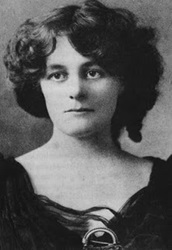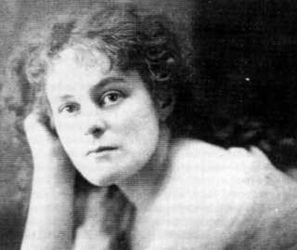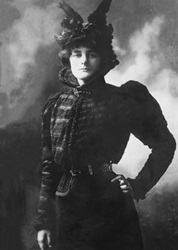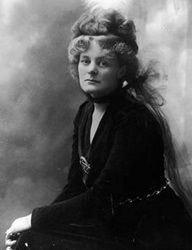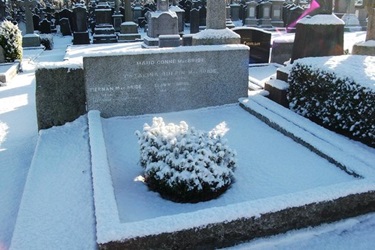Life
| 1865-1953 [usu. Maud Gonne [not Mrs. Gonne], later freq. Madame MacBride;] b. 21 Dec., 1866, at Tongham, nr. Aldershot, dg. of Thomas Gonne, army officer descended from a Tipperary planter family, afterwards London wine-merchants; her mother was mother Edith Frith née Cooke (d.1871), being dg. William Cooke an Englishman whose father William made a large fortune in wholesale merchandising [drapery] in Norfolk; her father was first posted to India and afterwards appt. Brig-Major at Curragh Camp, 1868 [var. 1869]; later appt. to command of 17th Lancers in England; the Gonnes lived variously at Athgarvan Hse (Curragh), Floraville (Eglinton Rd., Donnybrook), and a favourite house in Howth; after his appt. to the Lancers, Maud was ed. by governesses and in Provence; Col. Gonne appt. Dep. Adj. General in Dublin, 1885; presented to the Viceroy in Dublin Castle [court], 1885; suffered the death of her father from typhus, 1885; in France; acts as hostess to her father in Dublin from 1882 to his death in 1886 [var. 1885], by which time he had agreed to support her in her struggle for Home Rule as a result of the Land League movement (‘the people have a right to the land’); |
| settled with an dislikable uncle in London; received a trust-fund equal legacy of £80,000, with her sister Kathleen, from her late mother’s estate, 1886; embarked on career as actress, but prevented from proceeding by onset of TB; illness; while recovering from a haemorrhage at Royat in Auvergne, 1887, she met whe holidaying in Royat, and fell in love, Lucien Millevoye - a Boulangist [supporter of Gen. Boulanger], journalist and anti-semitic politician fighting for French possession of Alsace-Lorraine, whose mistress she became and with whom she had a son Georges Silvère [err. Georgette], 31 Aug. 1888 - MG retained his little boots all her life and died holding them; sickened by an eviction she witnessed at Falcarragh, Co. Donegal, 1888; spoke at Trade Union rally in Trafalgar Square, 1888; on her return to Dublin, she met childhood friend, Ida Jameson, and was introduced to C. H. Oldham, fndr. of Contemporary Club through which she met John O’Leary and his dg. Ellen; receives from the latter a letter of introduction to the Yeats family and meets W. B. Yeats when she visits them at Bedford Park, London, 30 Jan. 1889 (although she always insisted that they first met at the Contemporary Club); |
| introduced by Yeats to Order of Golden Dawn, 1890; admitted as a postulant, and member of the Isis-Urania Temple, 31 Nov. 1891 (motto: “Per Ignum Ad Lucem” [var. 16 Nov.]; travels to Paris, carrying the vellum book of poems Yeats had given her; deeply unhappy in relationship with Millevoye after he accused her of using sex for political gain, July 1891; suffered the loss of George, from meningitis, 31 Aug. 1891; bur. George in a crypt beneath cemetery chapel whose construction she funded at Samois-sur-Seine, south-east of Paris - with the the inscription, ‘Georges Gonne. Born January 11 1889. Died August 31 1891’; Yeats proposes marriage to her in Aug. 1891; MG travels on board the Irish mailboat which carried Parnell’s body back to Ireland, 7 Oct. 1891, while in mourning for her recently deceased son; met by Yeats on arrival at Kingstown; she attends Parnell’s funeral at Glasnevin and reports having witnessed with others a ‘shooting star’; tells Yeats that a child she had adopted had died (i.e., George); encouraged by George [“Æ”] Russell to believe that an infant soul can be reincarnated within a family; edits Journal des voyages, in which [s]he prints “Le Martyre de l’Irelande” in 6 issues (1891-94); |
| a second child born in August 1894 [var. 1895], and christened Iseult Lucille Germaine [Gonne] (1895-1954) -having been conceived a second child with Millevoye, reputedly in the crypt were the first child, George, was lain; though understood to be hers, the child was referred to in Dublin as an ‘adopted niece’; fnd. L’Irlande libre, organe de la colonie irlandaise à Paris, ed. with Miss M. Barry Delaney from May 1897 in 6 rue des Martyrs (9é. Arr.); Yeats writes The Countess Kathleen for her, 1892, and they argue over performance rights; tours Ireland establishing branches (to the number of three) of the Irish Nat. Lit. Soc. Library; lectures on the Irish Famine in Luxembourg; finds herself excluded as a woman from National Literary Society and National League (successor to Land League); settles in apartment at 7 Ave. d’Eylau, Place Victor Hugh, Paris, 1895; projects with Yeats a ‘Castle of Heroes’ to be built on Lough Key, Co. Roscommon, 1896-1902; demonstrates against Queen Victoria’s Diamond [60th] Jubilee celebrations in Dublin by decorating patriot graves (‘Must the graves of our dead go undecorated because Victoria has her jubilee?’) and organises mock funeral of British Empire on Jubilee Night; |
| addresses meetings, with Yeats, as part of the Wolfe Tone Commemoration Committee, aiming to erect statues of Tone (St. Stephen’s Green) and Gen. Humbert (Ballina), causing Anne Horniman to say: ‘The greatest poet ... is always helpless beside a beautiful woman screaming from a cart’ [ acc. Hone, W. B. Yeats, p.210]; refuses to support Yeats against Sir Charles Gavan Duffy in the Irish National Library publishing fracas; confesses her physical relationship with Millevoye to Yeats, 1898; breaks with Millevoye because of his connection with another woman, 1899; confesses to Yeats ‘with clenched hands’ her ‘horror and terror of physical love’ (Memoirs ); protested against Queen Victoria during her three-week visit in July 1900; contribs. “The Famine Queen” in The United Irishman on arrival of Queen Victoria in Dublin (4 April 1900); organised counter-demonstration of 40,000 children, culminating in oath-taking ceremony in Drumcondra, April 1900; |
| accuses Yeats of making her do the only cowardly thing in her life when he restrained her from joining riots (‘Maud has a look of exultation as she walks with her laughing head thrown back’, acc. to WBY in Autobiographies); fnds. Inghinidhe na h-Éireann [Daughters of Ireland], 1900, acting as President with Jenny Wyse Power as VP, 1900-01 [var. Ethna Carbery to 1902]; appears majestically in the tableau The Last Feast of the Fianna (1900), performed at Lughnasa, 1900; Inghinidhe na hEireann stages Eilís agus an Bhean Déirce, a one-act play by P. T. MacFhionnlaoich (Antient Concert Rooms, 27 Aug. 1901); residing at Couston Ave., nr. George Russell, 1902-06; plays title-role in the Yeats/Gregory Cathleen ni Houlihan ( 2-4 April 1902), appearing at the theatre dressed as the Old Woman for the first performance; refuses Yeats’s second offer of marriage (‘The world will thank me for not marrying you’); vetoed Lady Gregory’s Twenty-Five in 1902 on grounds it made emigration seem too lucrative; |
| travels to America with John McBride on anti-Boer War funding trip, meeting Tom Clarke whose best man McBride was at his wedding to Kathleen Daly there, 1901; converts to Catholicism, being formally received in baptism into Church at Chapel Des Dames de St. Thérèse, Laval - where Iseult was a student, Feb. 1903, Victor Collins acting as godparent; m. John MacBride, 21 Feb. 1903, Église [de] St. Honore d’Eylau, Place Victor Hugo, Paris, shocking Yeats with the announcement in a telegram beforehand; honeymoons in Algeciras, at the time of the Edward II’s visit to Gibraltar, and possibly gets involved in a Fenian assassination plot against him; her first accounts of MacBride’s drunkenness date from this time; co-opted as a member of National Council protesting visit of Edward VII; foments hostility against the plan to present a Loyal Address to the Edward VII at his forthcoming Irish visit, 1903; |
| hangs out a black petticoat on a broomstick for death of Leo XIII in contrast with the Union Jacks flown in the King’s honour; spends summer of 1903 in Coleville [Calvados], Normandy; visited there by the Collinses; returns to Paris, first staying at Hôtel Florence, rue de Mathurins, and soon afterwards purchases a house at 13 Rue de Passy, close to prev. home; asserts that WBY had given the rights of Kathleen ni Houlihan [hUallachan] to her; stages a walk-out during the first performance of In the Shadow of the Glen (Oct. 1903) by J. M. Synge, together with Dudley Digges, Máire Quinn, all of these resigning with others from Irish National Dramatic Co. in protest against the play’s ‘anti-Irish’ libel, and contrib. ‘A National Theatre’, to United Irishman (24 Oct. 1903, pp.2-3, (‘I would ask for freedom from the insidious and destructive tyranny of foreign influence’); her own play Dawn, an anti-English Famine play, was unstaged but publ. United Irishman (29 Oct. 1904); Seaghan [afterwards Seán], a son, b. Paris 26 Jan. 1904, Paris; breakdown of marriage with MacBride; travels to France to avoid MacBride’s gaining custody of Seaghan, 25 Nov. 1904; |
| makes petition to a Paris court accusing MacBride of drunkenness, violence, and sexual assault [‘pires immoralités’] on her 18 year-old half sister (who soon after married MacBride’s brother Joseph), 3 Feb. 1905; privately proposes that MacBride join the American army as a compromise solution; wins judicial separation from MacBride after an in camera hearing [enquette], 21 Nov. 1905 and days after; this followed by an open hearing and judgement, July-Aug., 1906 in which the immorality charges against MacBride are rejected; with Seaghan, meets MacBride under auspices of R. Barry O’Brien, London, Christmas 1904-05; still living at 26 Couston Ave., Rathgar, in Nov. 1904; conveys disappointment at the failure of her divorce suit in a letter to W. B. Yeats; gives interview to the Paris correspondent of NY Evening World which appeared under the caption, ‘A Brainy Woman should Not Wed’ (13 Aug. 1905); enters Abbey Theatre for the first night of Lady Gregory’s The Gaol Gate with Yeats in 1905, and boo’d by audience (‘Up John MacBride!’); later hissed when attending Abbey with Yeats and her son Sean, Oct. 1906; |
| achieves extension of the Free Meals legislation to Irish school-children, 1906; unsuccessfully appeals adverse decision in divorce case, March 1907; gets Church separation from MacBride, Jan. 1908; prob. consummates her relationship with Yeats in Dec. 1908, on evidence of letters; fnd. Bean na hEireann (1908), ed. by Helena Molony; organises meals for children effected by Dublin floods, St. Audoen’s Church, 1910, and poor school children from Harcourt St. Sinn Féin offices (acc. Police reports, 1911)]; remains in Paris at her apartment in Passy, spending summers at Les Mouettes, Colville [var. Colleville], nr. Calvados, to 1917, after MacBride’s execution for his part in the 1916 Rising; joined in Paris by Yeats and Everard Fielding (sec. of Psychical Soc.), and visits with them the bleeding pictures at Mirabeau, nr. Poitiers - soon after shown to be inauthentic miracles by Lister Inst.- and kneels at the scene, May 1914; Yeats proposes to her again, and then with her permission to Iseult, in Normandy; crosses to Dublin disguised as nurse, Feb. 1918 [err. Dec., Tuohy]; turned away by Yeats from 73, St. Stephen’s Green (the house she rented and allowed him to use), Mrs Yeats being pregnant and suffering from pneumonia; arrested in Dublin, May 1918, and imprisoned in Holloway for five-and-a-half months, being released with suspected tuberculosis after intervention by Yeats; released into nursing home in London, due to illness; |
| returns to 73 St. Stephen’s Green, then rented to the Yeats - disguised in Red Cross nurse’s uniform, Christmas 24 Nov. 1918; refused entry by Yeats (‘still the lunatic refused to go’ - acc. Lily) pressures Iseult and Francis Stuart into church marriage after their elopement to London, 1920; initially supports the Treaty side in the Civil War but turns to the Republicans after the attack on the Four Courts; acted as White Cross relief; arrested January 1923 (informing Yeats a day previously that ‘if I did not denounce the Government, she renounced my society for ever’); Free State soldiers burn many of Yeats’s letters to her when they raid her house; allows her house to be used for publication of second issue of Con Levanthal’s and Francis Stuart’s paper To-morrow, 1924; supports Hanna Sheehy-Skeffington in The Plough and the Stars controversy and attends the public debate with O’Casey at the Universities’ Republican Club, 1926; subject of a tribute for work on behalf of republican prisoners, 1932, being described by Brigit O’Hullane as ‘one of the greatest Irishwoman who ever lived’; |
| issues A Servant of the Queen, an autobiography of her life up to her marriage, serialised in The Irish Press (1938-39) and celebrating sacrificial nationalism (‘life out of death, life out of death eternally’) - the point de départ of a noted passage in McNeice’s Autumn Journal (1939); visits Yeats at Riversdale shortly before his death (‘Maud, we should have gone on with our Castle of Heroes, we might still do it’); an IRA man arrested by the police is found to have a letter signed Maud Gonne MacBride (Yeats: ‘What a woman! What vitality! What energy!’); lived latterly at Roebuck House, Clonskea [Co. Dublin]; d. of cancer - purportedly saying, ‘I feel now an ineffable joy’, 27 April 1953; bur. in the Republican plot, Glasnevin; made no reference to Maud in her will but asked to be buried with George’s little shoes; there is an unfinished autobiographical manuscript of her later years entitled ‘The Tower of Age’; Ethel Mannin dedicated Connemara Journal (1947) to ‘Maud Gonne MacBride’. DIB DIH FDA OCIL |
[ top ]
|
||||||||
[ See Maud Gonne at the “Irish in Paris” website; accessed 29.12.2012. ]
Works
| Plays |
|
| Prose |
|
| Correspondence |
|
| Miscellaneous |
|
|
[ top ]
Criticism
|
|
See also ... |
|
| [ top ] |
Commentary
See separate file, infra.
[ top ]
Quotations
See separate file, infra.
[ top ]
Notes
Heart’s desire: Yeats recorded a dream shared with Maud Gonne in 1889, when she told him of sexual relations with Lucien Millevoye: ‘She thought herself a great stone statue through which passed flame, and I felt myself becoming flame and mounting up through and looking out of the eyes of a great stone Minerva.’ (Donoghue, ed., Memoirs, 1972, p.134.[ top ]
Yeats’s Proposal: Maud Gonne refused Yeats’s marriage proposal in these terms: ‘No Willie, the world will thank me for not marrying you. Let us continue to be such close friends - and go on writing me those lovely poems.’ (Intro., Love Poems by W. B. Yeats, Kyle Cathie, 1990, p.5; cited in Gaw, UUC MA 1999’).
Georg(ette): According to some biographers, Gonne’s first child was a boy called George; according to others a girl called Georgette, born in May 1889 (See Levenson, 1977).
Untitled manuscript: ‘The essay on the bleeding oleograph is in the handwriting of Maud Gonne, who wrote at Yeats’s dictation. It begins with the arrival at Mirabeau of Yeats, Maud, and Everard Feilding [freq. Fielding], who had been sent to “investigate a miracle”, and ends with their leaving impressed but uncertain. Two months later Feilding informed Yeats that the blood was not human blood. Always eager to experiment, Yeats was never credulous.’ (See George Mills Harper, ed., Yeats and the Occult, London: Macmillan 1976, p.8 [Introd.].)
Cathleen Ni Houlihan : In the All-Ireland Review, edited by Standish James O’Grady, a notice on Cathleen Ni Houlihan (1902), spoke of ‘Maud Gonne, the well-known nationalist agitator, addressing not the actors, as is usual in the drama, but the audience’ (Roy Foster, Apprentice Mage, 1996, p.367; cited in Richard Mitchell, BA Diss., 1997.)
Icon of Nationalism: Dorothy MacArdle testifies that Cathleen Hi Houlihan became one of the sacred works of Sinn Féin and the Republican Movements (The Irish Republic, Corgi 1968, p.58; cited in Flannery, 1976, p.100).
In the Shadow of the Glen: Gonne walked out of the first performance of In the Shadow of the Glen, 8 Oct. 1903 (see K. P. S. Jochum, ‘Maud Gonne on Synge’, in Éire-Ireland, Winter 1971, p.67).
Denis Johnston refers to the early revolutionary period as ‘the Maud Gonne era’. (See the Introduction to The Scythe and the Sunset, reprinted in Dublin Magazine, Spring 1966.)
Catholic baptism: Maud Gonne was baptised in the Roman Catholic religion by Monsignor Pierre-Joseph Geary, Bishop of Laval, Feb. 1903. (See Conor Cruise O’Brien, Ancestral Voices, Poolbeg 1994, pp.70ff.).
Bleeding Hearts: W. B. Yeats and Maud Gonne visited a supposedly blood-secreting oil painting of Sacred Heart at Mirabeau in France; Maud Gonne fell to her knees; Lister Institute tested exudate swabbed by the local curé and found it to be other than human. (See Brenda Maddox, Yeats’s Ghosts, 1999, p.13.)
[ top ]
“Easter 1916”: Maud Gonne, to whom Yeats’s ‘Easter 1916’ was read in August on a seashore in Normandy, found the poem ‘wholly inadequate to the occasion,’ according to Rothenstein, quoted by J. H. Hone, in W. B. Yeats 1865-1939 (London 1965), p.300. She wrote elsewhere on the deaths of the 1916 Rising leaders, ‘The deaths of those leaders are full of beauty and romance. They will be speaking forever, the people will hear them forever’ (quoting Yeats’s Cathleen ni Houlihan ; q. source; poss. review of Gonne-Yeats letters.]
Sex with Yeats: The probable date at which Gonne and W. B. Yeats consummated their relationship in the later period (that is, after her divorce from MacBride), has been put at circa Dec. 1908, on the basis of the letters of that period; on 26 Jan. 1908 she wrote to Yeats of a ‘wonderful’ dream-experience in which ‘we melted into one another till we formed only one being, a being greater than ourselves ...’; she subsequently wrote to him: ‘I will pray with my whole strength that suffering & temptation may be taken from you as they have from me & that we may gain spiritual union stronger than earthly union could ever be.’ (May 1909). Yeats’s poetic reaction, “A Memory of Youth”, was as follows: ‘We sat silent as a stone, / We knew, though she’d not said a word, / That even the best of love must die, / And had been savagely undone / Were it not that Love upon the cry / Of a most ridiculous little bird / Tore from the clouds his marvellous moon.’ (See A N. Jeffares, W. B. Yeats A New Biography, 1988.)
Town house: Maud Gonne received from Madame Despard, radical socialist and sister of Lord French, the gift of her Dublin home when the latter moved to Belfast. (See under Despard in Hickey & Doherty, eds., Dictionary of Irish History, 1980..
SF Founder: Maud Gonne sometimes claimed to have founded Sinn Féin in a smuch as she called a meeting in her Rathgar house attended by Arthur Griffith, Edward Martyn, Henry Dixon, and Alderman Tom Kelly - styling themselves at first the Irish National Council with a view to selecting a delegate for the Irish Parliamentary Party’s annual convention.
Francis Stuart: In Black List, Section H (1971; 1975): Stuart gives an account of his first meeting with Maud Gonne at her home on St. Stephen.s Green during one of her Tuesdays, when she ‘denounc[ed], with agonising fervor, the British Empire’ in conversation with a British-army relative, Richard Purcell (who was accompanying Stuart on the visit), and leading Stuart to realise to ‘grasp’ that it was ‘a fury that had nothing personal in it’: ‘He senses in that moment [...] that there were those who fastened on causes as an outlet for passios whcih weren’t fulfilled through their senses and that they had a puritan lack of complexity in them that to him was alien.’ (London: Martin Brian O‘Keeffe 1975, p.15.)
Ineffable Maud: Maud Gonne-MacBride’s last words before her death on 17 April 1953 were: ‘I feel now an ineffable joy’, as reported in a letter from Iseult to Francis Stuart. (See Geoffrey Elborn, Francis Stuart, 1990, p.236.)
Brian Moore, in Judith Hearne (1955): ‘Maud Gonne MacBride, once the most beautiful woman in Ireland’ (p.214), spoken in the course of Judith’s fantasy of life as grande dame in the Catholic Irish milieu of this novel.
Brendan Behan used to perform a comic turn called ‘Maud Gonne at the Microphone’ , with a towel around his head, consisting of ‘fruity recollections of Yeats in a quavering, aged, but, of certain undertones, deeply expressive voice.’ (Anthony Cronin, Dead as Doornails, 1976; cited in cited in P. J. Kavanagh, Voices in Ireland, 1994, p.290.)
[ top ]
Two Broomsticks: On the subject of Maud Gonne hanging out a black petticoat on a broomstick for Leo XIII in contrast with Union Jacks officially displayed to honour Edward in 1903, Conor Cruise O’Brien wonders how she got around without her ‘usual mode of conveyance’. (See O’Brien, Ancestral Voices: Religion and Nationalism in Ireland, Dublin: Poolbeg 1994, q.p.)
Annie Smithson, novel issued a novel based on the career of Maud Gonne entitled The Walk of a Queen (1922).
Shambles Corner (London: Flamingo 1993, 320pp.) is a satirical novel by Edward Toman - a founder of the NI Civil Rights Movement - with Dr. Oliver Cromwell McCoy, Father Schnozzl Durante; Maud Gonne McGuffin, Francis Xavier Pacelli Feely, Sister Immaculata Mcgillacuddy and Cardinal Big Mac Maguire as characters.
Tarahan dynasty: Arthur Griffith and Maud Gonne walked on Tara Hill, Christmas Day 1900, inspecting damage done to the site.
Dreamy dreams: Ella Young [q.v.] had a dream of Maud Gonne in which the latter was ‘dressed all grey with a darkness about her’ ... while Mrs. Russell ‘had a dream ten days earlier in which Maud Gonne came to her weeping and saying she did not know what to do or where to hide herself.’ (George Russell, letter to W. B. Yeats of [?28 April 1903], in Letters from AE; ed. Alan Denson, London: Abelard-Schuman 1961, p.45-46.)
Note: Linde Lunney suggests that Young, who shared an apartment with Maud Gonne in Paris, may have been in love with her (“Ella Young”, in The Dictionary of Irish Biography (RIA 2009).
Francis Stuart writes of travelling to Lourdes with Iseult and Maud Gonne: ‘In the morning he went to town with Iseult while her mother took a mud bath and drank the water from the hot springs. she who had once inspired Yeats’s love poetry now only asked for some amelioration of the aches in her joints.’ (Black List, Section H, London: Martin, Brian & O’Keeffe, 1975, p.160.) According to Stuart, Iseult referred to her mother as “Moura” while she herself is generally passed off as an adopted child.
Portraits (1): A charcoal portrait by Séan O’Sullivan (1929), is held by the National Gallery of Ireland [Breffny, ed., Cultural Encyclopedia, p.177]; an oil portrait by Sarah Purser also hangs in Municipal Gallery, and there is a bust by Laurence Campbell in the Municipal Gallery, Dublin, which Yeats made the subject of a “A Bronze Head” (‘Human, superhuman, a bird’s round eye, / Everything else withered and mummy-dead’ (Collected Poems, p.382); shown in Hone, W. B. Yeats (p.502), though actually painted bronze.Also, ‘But even at the starting-post, all sleek and new, / I saw the wildness in her.’ (Quoted in Brenda Maddox, Yeats’s Ghosts: The Secret Life of W. B. Yeats, NY: HarperCollins 1999, p.367.)
Portraits (2): A chalk drawing in profile of Iseult MacBride (1894-1954) by her mother and an oil of the same by George Russell [in possession of Ian Stuart], were both shown in the NGI Yeats Centenary Exhibition of 1965. See also numerous photographs and portraits illustrating A. N. Jeffares, W. B. Yeats: A New Biography (1988).
Portraits (3): A portrait of Maud Gonne by Sarah Purser hangs in Municipal Gallery (See Catherine Fay, W. B. Yeats and His Circle, NLI 1989, Chap. 6); see also Anne Crookshank, Ulster Muswum Portrait Exhibition (1965); also J. M. Hone, W. B. Yeats (1942), p.102; Frank Tuohy, Yeats (1976), p.172; James W. Flannery, Yeats and the Idea of a Theatre (Toronto: Macmillan 1976; rep. Yale UP 1989), pl. 4 [Maud Gonne as Cathleen ni Houlihan; permission of Michael Yeats].
Suellen Hoy, ‘The Irish Girls’ Rising: Building the Women’s Labor Movement in Progressive-Era Chicago’, in Labor, 9, 1 (2012), pp.77-100: The Chicago Women’s Trade Union League (CWTUL) inaugurated at Hull House in 1904, had its roots in short-lived Maud Gonne Club, the 1900 stockyard strike of Irish women, and Local 183 of the Amalgamated Meat Cutters, the first women’s union in the stockyards. Mary E. McDowell, head resident of the University of Chicago Settlement and advisor to Local 183, served as CWTUL’s first president from 1904 to 1907. The working-class leadership of the Chicago branch - unlike its better-known counterpart in New York - was “old immigrant” (primarily Irish Catholic but also including Germans and Scandinavians) with a distinct culture that derived from its ethnic makeup and its settlement-house attachments. In “The Irish Girls’ Rising,” Suellen Hoy explores these developments and highlights CWTUL’s significance in building the women’s labor movement in Chicago at the turn of the twentieth century.’ (Irish Diaspora email notice from Margaret Preston, Augustana College, Sioux Falls; 03.06.2012.)
[ top ]
|
